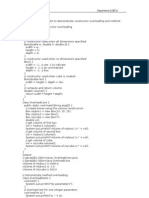OOP Lab Manual
Uploaded by
Joelkrupakar GutlaOOP Lab Manual
Uploaded by
Joelkrupakar GutlaObject Orieted Programming Lab
II Year B.Tech III SEM (MR 20)
2021-2022
LAB OBJECTIVE
1. Ability to learn and understand the concepts and features of object oriented
programming and the object oriented concept like inheritance and will know how to
make use of interfaces and package.
2. To acquire the knowledge in Java’s exception handling mechanism, multithreading, to
explore concepts of Applets and event handling mechanism.
3. Ability to explore the concepts like Layout Manager and swings.
DEPT.OF IT Object Or iented Pr ogr amming Lab
1: Write Java Programs that implement the following..
a) Constructor
b) Parameterized constructor
c) Method overloading
d) Constructor overloading
a)Constructor is a block of code that initializes the newly created object. A constructor resembles
an instance method in java but it’s not a method as it doesn’t have a return type. In short
constructor and method are different(More on this at the end of this guide). People often refer
constructor as special type of method in Java.
Program:
public class Hello {
String name;
//Constructor
Hello(){
this.name = "BeginnersBook.com";
}
public static void main(String[] args) {
Hello obj = new Hello();
System.out.println(obj.name);
}
}
Output:
BeginnersBook.com
b)
class Example{
//Default constructor
Example(){
System.out.println("Default constructor");
}
/* Parameterized constructor with
* two integer arguments
*/
Example(int i, int j){
MREC (A) Page No:5
DEPT.OF IT Object Or iented Pr ogr amming Lab
System.out.println("constructor with Two parameters");
}
/* Parameterized constructor with
* three integer arguments
*/
Example(int i, int j, int k){
System.out.println("constructor with Three parameters");
}
/* Parameterized constructor with
* two arguments, int and String
*/
Example(int i, String name){
System.out.println("constructor with int and String param");
}
public static void main(String args[]){
//This will invoke default constructor
Example obj = new Example();
/* This will invoke the constructor
* with two int parameters
*/
Example obj2 = new Example(12, 12);
/* This will invoke the constructor
* with three int parameters
*/
Example obj3 = new Example(1, 2, 13);
/* This will invoke the constructor
* with int and String parameters
*/
Example obj4 = new Example(1,"BeginnersBook");
}
}
Output:
Default constructor
constructor with Two parameters
constructor with Three parameters
constructor with int and String param
MREC (A) Page No:6
DEPT.OF IT Object Or iented Pr ogr amming Lab
c)
In order to overload a method, the argument lists of the methods must differ in either of these:
1. Number of parameters.
For example: This is a valid case of overloading
add(int, int)
add(int, int, int)
2. Data type of parameters.
For example:
add(int, int)
add(int, float)
3. Sequence of Data type of parameters.
For example:
add(int, float)
add(float, int)
Pgm:
class DisplayOverloading
{
public void disp(char c)
{
System.out.println(c);
}
public void disp(char c, int num)
{
System.out.println(c + " "+num);
}
}
class Sample
{
public static void main(String args[])
{
DisplayOverloading obj = new DisplayOverloading();
obj.disp('a');
obj.disp('a',10);
}
}
MREC (A) Page No:7
DEPT.OF IT Object Or iented Pr ogr amming Lab
Output:
a
a 10
d) Constructor Overloading:
class StudentData
{
private int stuID;
private String stuName;
private int stuAge;
StudentData()
{
//Default constructor
stuID = 100;
stuName = "New Student";
stuAge = 18;
}
StudentData(int num1, String str, int num2)
{
//Parameterized constructor
stuID = num1;
stuName = str;
stuAge = num2;
}
//Getter and setter methods
public int getStuID() {
return stuID;
}
public void setStuID(int stuID) {
this.stuID = stuID;
}
public String getStuName() {
return stuName;
}
public void setStuName(String stuName) {
this.stuName = stuName;
}
public int getStuAge() {
return stuAge;
}
public void setStuAge(int stuAge) {
this.stuAge = stuAge;
}
public static void main(String args[])
MREC (A) Page No:8
DEPT.OF IT Object Or iented Pr ogr amming Lab
{
//This object creation would call the default constructor
StudentData myobj = new StudentData();
System.out.println("Student Name is: "+myobj.getStuName());
System.out.println("Student Age is: "+myobj.getStuAge());
System.out.println("Student ID is: "+myobj.getStuID());
/*This object creation would call the parameterized
* constructor StudentData(int, String, int)*/
StudentData myobj2 = new StudentData(555, "Chaitanya", 25);
System.out.println("Student Name is: "+myobj2.getStuName());
System.out.println("Student Age is: "+myobj2.getStuAge());
System.out.println("Student ID is: "+myobj2.getStuID());
}
}
Output:
Student Name is: New Student
Student Age is: 18
Student ID is: 100
Student Name is: Chaitanya
Student Age is: 25
Student ID is: 555
MREC (A) Page No:9
Infor mation Technology Object Or iented Pr ogr amming Lab
2. Write a Java program
a) checks whether a given string is a palindrome or not.
b) for sorting a given list of names in ascending order.
c) that reads a line if integers and then displays each integer and the sum of all integers( use
string tokenizer class of java.util).
a)
Program:
import java.util.Scanner;
class ChkPalindrome { public static void main(String args[])
String str, rev = "";
Scanner sc = new Scanner(System.in);
System.out.println("Enter a string:");
str = sc.nextLine();
int length = str.length();
for ( int i = length - 1; i >= 0; i-- )
rev = rev + str.charAt(i);
if (str.equals(rev))
System.out.println(str+" is a palindrome");
else System.out.println(str+" is not a palindrome"); } }
OutPut:
Enter a string:
radar
radar is a palindrome
MREC (A) Page
No:10
Infor mation Technology Object Or iented Pr ogr amming Lab
b)
class sorting
{
public static void main(String[] input)
{
int k=input.length;
String temp=new String();
String names[]=new String[k+1];
for(int i=0;i<k;i++)
{
names[i]=input[i];
}
for(int i=0;i<k;i++)
for(int j=i+1;j<k;j++)
{
if(names[i].compareTo(names[j])<0)
{
temp=names[i];
names[i]=names[j];
names[j]=temp;
}
}
System.out.println(“Sorted order is”);
for(int i=0;i<k;i++)
{
System.out.println(names[i]);
}
}
}
OutPut:
Java sorting Harish Ramesh Mahesh Rakesh
Sorted order is
Ramesh
Rakesh
Mahesh
Harish
Java sorting sai hari teja ravi sandeep
Sorted order is
teja
MREC (A) Page
No:11
Infor mation Technology Object Or iented Pr ogr amming Lab
sandeep
sai
ravi
hari
c) That reads a line if integers and then displays each integer and the sum of all integers
import java.io.*;
import java.util.Scanner;
import java.util.StringTokenizer;
class StringTokenizerEx
{
public static void main(String[] args) throws IOException
{
BufferedReader br = new BufferedReader(new InputStreamReader(System.in));
//Scanner objScanner = new Scanner(System.in);
System.out.print("\nEnter A Line Of Integers:");
//String line = objScanner.nextLine();
String line = br.readLine();
StringTokenizer st = new StringTokenizer(line);
System.out.println("\nNumber of tokens : "+st.countTokens());
long sum = 0;
System.out.print("\nTokens are : \n" );
while (st.hasMoreTokens())
{
long i = Long.parseLong(st.nextToken());
System.out.print(i + "\n");
sum = sum + i;
}
System.out.println("\nThe Sum Is :" +sum);
}
}
Output:
Enter A line of integers: 1 4 23 2
Number of tokens: 4
Tokens are:
1 4 23 2
The sum is : 30
MREC (A) Page
No:12
Infor mation Technology Object Or iented Pr ogr amming Lab
3) Write Java programs that uses the following keywords...
a) this
b) super
c) static
d) final
a)
class Student{
int rollno;
String name;
float fee;
Student(int rollno,String name,float fee){
rollno=rollno;
name=name;
fee=fee;
}
void display(){System.out.println(rollno+" "+name+" "+fee);}
}
class TestThis1{
public static void main(String args[]){
Student s1=new Student(111,"ankit",5000f);
Student s2=new Student(112,"sumit",6000f);
s1.display();
s2.display();
}}
OUTPUT :
0 null 0.0
0 null 0.0
b)
class Superclass
{
int num = 100;
MREC (A) Page
No:13
Infor mation Technology Object Or iented Pr ogr amming Lab
}
//Child class or subclass or derived class
class Subclass extends Superclass
{
/* The same variable num is declared in the Subclass
* which is already present in the Superclass
*/
int num = 110;
void printNumber(){
System.out.println(num);
}
public static void main(String args[]){
Subclass obj= new Subclass();
obj.printNumber();
}
}
Output:
110
c)
class Student8{
int rollno;
String name;
static String college ="ITS";
Student8(int r,String n){
rollno = r;
name = n;
}
void display (){System.out.println(rollno+" "+name+" "+college);}
public static void main(String args[]){
Student8 s1 = new Student8(111,"Karan");
Student8 s2 = new Student8(222,"Aryan");
s1.display();
s2.display();
}
MREC (A) Page
No:14
Infor mation Technology Object Or iented Pr ogr amming Lab
Output:
111 Karan ITS
222 Aryan ITS
d)
class Gfg
{
public static void main(String[] args)
{
// a final reference variable sb
final StringBuilder sb = new StringBuilder("Geeks");
System.out.println(sb);
// changing internal state of object
// reference by final reference variable sb
sb.append("ForGeeks");
System.out.println(sb);
}
}
Output:
Geeks
GeeksForGeeks
MREC (A) Page
No:15
Infor mation Technology Object Or iented Pr ogr amming Lab
4) Java program to implement
a) Method Overloading
b)dynamic method dispatch
c) multiple inheritance
d) access specifiers
a)
class Adder{
static int add(int a,int b){return a+b;}
static int add(int a,int b,int c){return a+b+c;}
}
class TestOverloading1{
public static void main(String[] args){
System.out.println(Adder.add(11,11));
System.out.println(Adder.add(11,11,11));
}}
Output:
22
33
b)
// A Java program to illustrate Dynamic Method
// Dispatch using hierarchical inheritance
class A
{
void m1()
{
System.out.println("Inside A's m1 method");
}
}
class B extends A
{
// overriding m1()
void m1()
{
System.out.println("Inside B's m1 method");
MREC (A) Page
No:16
Infor mation Technology Object Or iented Pr ogr amming Lab
}
}
class C extends A
{
// overriding m1()
void m1()
{
System.out.println("Inside C's m1 method");
}
}
// Driver class
class Dispatch
{
public static void main(String args[])
{
// object of type A
A a = new A();
// object of type B
B b = new B();
// object of type C
C c = new C();
// obtain a reference of type A
A ref;
// ref refers to an A object
ref = a;
// calling A's version of m1()
ref.m1();
// now ref refers to a B object
ref = b;
// calling B's version of m1()
ref.m1();
// now ref refers to a C object
ref = c;
// calling C's version of m1()
ref.m1();
MREC (A) Page
No:17
Infor mation Technology Object Or iented Pr ogr amming Lab
}
}
OUTPUT:
Inside A's m1 method
Inside B's m1 method
Inside C's m1 method
C) Multiple Inheritance
Inheritance allows us to define a class in terms of another class, which makes it easier to
create and maintain an application. This also provides an opportunity to reuse the code
functionality and fast implementation time.
When creating a class, instead of writing completely new data members and member
functions, the programmer can designate that the new class should inherit the members of an
existing class. This existing class is called the baseclass, and the new class is referred to as
the derived class.
The idea of inheritance implements the is a relationship.
A derived class can access all the non-private members of its base class. Thus base-class
members that should not be accessible to the member functions of derived classes should be
declared private in the base class.
Program code:
/* program for basic inheritance concept*/
#include <iostream>
using namespace std;
// Base class
class Shape
{
public:
void setWidth(int w)
{
width = w;
}
void setHeight(int h)
{
height = h;
MREC (A) Page
No:18
Infor mation Technology Object Or iented Pr ogr amming Lab
}
protected:
int width;
int height;
};
// Derived class
class Rectangle: public Shape
{
public:
int getArea()
{
return (width * height);
}
};
int main(void)
{
Rectangle Rect;
Rect.setWidth(5);
Rect.setHeight(7);
// Print the area of the object.
cout << "Total area: " << Rect.getArea() << endl;
return 0;
}
Output:
Total area 35
Program code:
/* Program for multiple inheritance*/
#include <iostream>
using namespace std;
// Base class Shape
class Shape
{
public:
void setWidth(int w)
{
width = w;
}
void setHeight(int h)
MREC (A) Page
No:19
Infor mation Technology Object Or iented Pr ogr amming Lab
{
height = h;
}
protected:
int width;
int height;
};
// Base class PaintCost
class PaintCost
{
public:
int getCost(int area)
{
return area * 70;
}
};
// Derived class
class Rectangle: public Shape, public PaintCost
{
public:
int getArea()
{
return (width * height);
}
};
int main(void)
{
Rectangle Rect;
int area;
Rect.setWidth(5);
Rect.setHeight(7);
area = Rect.getArea();
// Print the area of the object.
cout << "Total area: " << Rect.getArea() << endl;
// Print the total cost of painting
cout << "Total paint cost: $" << Rect.getCost(area) << endl;
return 0;
}
MREC (A) Page
No:20
Infor mation Technology Object Or iented Pr ogr amming Lab
Output:
Total area: 35
Total paint cost: $2450
d)
Access specifier
Java has defined four types of access specifiers. These are :
1. Public
2. Private
3. Protected
4. Default
package xyz;
import abc.AccessDemo;
public class AccessExample
{
public static void main(String[] args)
{
AccessDemo ad = new AccessDemo();
ad.test();
}
}
class AccessDemo
{
private int x = 56;
public void showDemo()
{
System.out.println("The Variable value is " + x);
}
private void testDemo()
{
System.out.println("It cannot be accessed in another class");
}
}
MREC (A) Page
No:21
Infor mation Technology Object Or iented Pr ogr amming Lab
public class AccessExample
{
public static void main(String[] args)
{
AccessDemo ad = new AccessDemo();
ad.testDemo(); // Private method cannot be used
ad.x = 5; // Private variable cannot be used
ad.showDemo(); // run properly
}
}
package abc;
class AccessDemo
{
default int a = 4;
}
package xyz;
import abc.AccessDemo;
class AccessExample
{
public static void main(String[] args)
{
AccessDemo ad = new AccessDemo();
ad.a = 67; //It is not possible.
}
}
class AccessDemo
{
protected int x = 34;
public void showDemo()
{
System.out.println("The variable value is " + x);
}
}
MREC (A) Page
No:22
Information Technology Object Oriented Programming Lab
class ChildAccess extends AccessDemo
{
// child class which inherits
// the properties of AccessDemo class
}
public class AccessExample
{
public static void main(String[] args)
{
ChildAccess ca = new ChildAccess();
ca.showDemo(); // run properly
ca.x = 45; // run properly
}
}
MREC (A) Page
No:23
Infor mation Technology Object Or iented Pr ogr amming Lab
5) Write a Java program that
a) reads a file name from the user, and then displays information about whether the file exists,
whether the file is readable, whether the file is writable, the type of file and the length of the file
in bytes.
b) reads a file and displays the file on the screen, with a line number before each
line.
c) displays the number of characters, lines and words in a text file.
a)
import java.io.*;
import java.util.*;
class AboutFile{
public static void main(String[] args){
Scanner input = new Scanner(System.in);
System.out.println("Enter the name of the file:");
String file_name = input.nextLine();
File f = new File(file_name);
if(f.exists())
System.out.println("The file " +file_name+ " exists");
else
System.out.println("The file " +file_name+ " does not exist");
if(f.exists()){
if(f.canRead())
System.out.println("The file " +file_name+ " is readable");
else
System.out.println("The file " +file_name+ " is not readable");
MREC (A) Page
No:24
Infor mation Technology Object Or iented Pr ogr amming Lab
if(f.canWrite())
System.out.println("The file " +file_name+ " is writeable");
else
System.out.println("The file " +file_name+ " is not writeable");
System.out.println("The file type is: " +file_name.substring(file_name.indexOf('.')+1));
System.out.println("The Length of the file:" +f.length());
}
}
}
b)
import java.io.*;
class linenum
{
public static void main(String[] args)throws IOException
{
FileInputStream fil;
LineNumberInputStream line;
MREC (A) Page
No:25
Infor mation Technology Object Or iented Pr ogr amming Lab
int i;
try
{
fil=new FileInputStream(args[0]);
line=new LineNumberInputStream(fil);
}
catch(FileNotFoundException e)
{
System.out.println("No such file found");
return;
}
do
{
i=line.read();
if(i=='\n')
{
System.out.println();
System.out.print(line.getLineNumber()+" ");
}
else
System.out.print((char)i);
}while(i!=-1);
fil.close();
line.close();
}
}
Output:
Demo.java
class Demo
1{
2 public static void main(java Demo beta gamma delta)
3{
4 int n = 1 ;
5 System.out.println(“The word is ” + args[ n ] );
6}
C)
import java.io.*;
class wordcount
{
MREC (A) Page
No:26
Infor mation Technology Object Or iented Pr ogr amming Lab
public static int words=0;
public static int lines=0;
public static int chars=0;
public static void wc(InputStreamReader isr)throws IOException
{
int c=0;
boolean lastwhite=true;
while((c=isr.read())!=-1)
{
chars++;
if(c=='\n')
lines++;
if(c=='\t' || c==' ' || c=='\n')
++words;
if(chars!=0)
++chars;
} }
public static void main(String[] args)
{
FileReader fr;
try
{
if(args.length==0)
{
wc(new InputStreamReader(System.in));
}
else
{
for(int i=0;i<args.length;i++)
{
fr=new FileReader(args[i]);
wc(fr);
}}
}
catch(IOException ie)
{
return;
}
System.out.println(lines+" "+words+" "+chars);
}}
Output:This is II CSE
1 4 32
Draw the frequency response
1 4 58
MREC (A) Page
No:27
Infor mation Technology Object Or iented Pr ogr amming Lab
6) Write a Java program for handling
a) Checked exceptions.
b) unchecked exceptions.
a) Predefined Exception: The most general of exceptions are subclasses of the standard type
RuntimeException. Since java.lang is implicitly imported into all Java programs, most
exceptions derived from RuntimeException are automatically available.
class Ex1
{
void div()
{
int b=10/0;
}
void div1()
{
div();
}
void div2()
{
try
{
div();
}
catch(Exception e)
{
System.out.println(e);
}
}
public static void main(String[] args)
{
Ex1 e=new Ex1();
e.div2();
}
}
O/P:
Java.lang..ArithmeticException:/by zero
User defined Exception: If you are creating your own Exception that is known as custom
exception or user-defined exception. Java custom exceptions are used to customize the exception
according to user need.
class MyException extends Exception
{
MREC (A) Page
No:28
Infor mation Technology Object Or iented Pr ogr amming Lab
public String toString()
{
return("myException");
}
}
class MyExceptionDemo
{
static void compute(int age) throws MyException
{
if(age<18)
throw new MyException();
else
System.out.println("elgible");
}
public static void main(String[] args)
{
try
{
compute(24);
compute(18);
}
catch(MyException e)
{
System.out.println(e);
}
}
}
O/P:
MyException
MREC (A) Page
No:29
Infor mation Technology Object Or iented Pr ogr amming Lab
7)Write a JAVA program
a) Creates three threads. First threads displays “Good Morning “for every one Second, the
second thread displays “Hello” for every two seconds, the third thread Displays “Welcome” for
every three seconds.
b) that correctly implements producer consumer problem using concept of inter
thread communication
a)
class A extends Thread
{
synchronized public void run()
{
try
{
while(true)
{
sleep(1000);
System.out.println("good morning");
}
}
catch(Exception e)
{}
}
}
class B extends Thread
{
synchronized public void run()
{
try
{
while(true)
{
sleep(2000);
System.out.println("hello");
}
}
catch(Exception e)
{}
}
}
class C extends Thread
MREC (A) Page
No:30
Infor mation Technology Object Or iented Pr ogr amming Lab
{
synchronized public void run()
{
try
{
while(true)
{
sleep(3000);
System.out.println("welcome");
}
}
catch(Exception e)
{}
}
}
class ThreadDemo
{
public static void main(String args[])
{
A t1=new A();
B t2=new B();
C t3=new C();
t1.start();
t2.start();
t3.start();
}
}
Output:
E:\javamani>java ThreadDemo
good morning
good morning
hello
good morning
welcome
good morning
hello
good morning
welcome
hello
good morning
good morning
hello
good morning
welcome
MREC (A) Page
No:31
Infor mation Technology Object Or iented Pr ogr amming Lab
good morning
hello
good morning
good morning
hello
welcome
good morning
b)
class Q
{
int n;
boolean valueSet=false;
synchronized int get()
{
if(!valueSet)
try
{
wait();
}
catch(InterruptedException e)
{
System.out.println("Interrupted Exception caught");
}
System.out.println("Got:"+n);
valueSet=false;
notify();
return n;
}
synchronized void put(int n)
{
if(valueSet)
try
{
wait();
}
catch(InterruptedException e)
{
System.out.println("Interrupted Exception caught");
}
this.n=n;
valueSet=true;
System.out.println("Put:"+n);
notify();
}
}
MREC (A) Page
No:32
Infor mation Technology Object Or iented Pr ogr amming Lab
class Producer implements Runnable
{
Q q;
Producer(Q q)
{
this.q=q;
new Thread(this,"Producer").start();
}
public void run()
{
int i=0;
while(true)
{
q.put(i++);
}
}
}
class Consumer implements Runnable
{
Q q;
Consumer(Q q)
{
this.q=q;
new Thread(this,"Consumer").start();
}
public void run()
{
while(true)
{
q.get();
}
}
}
class ProdCons
{
public static void main(String[] args)
{
Q q=new Q();
new Producer(q);
new Consumer(q);
System.out.println("Press Control-c to stop");
}
}
MREC (A) Page
No:33
Infor mation Technology Object Or iented Pr ogr amming Lab
Output:
Put:0
Press Control-c to stop
Got:0
Put:1
Got:1
Put:2
Got:2
Put:3
Got:3
Put:4
Got:4
Put:5
Got:5
Put:6
Got:6
MREC (A) Page
No:34
Infor mation Technology Object Or iented Pr ogr amming Lab
8. Develop an Applet that
a) Displays a simple message.
b) receives an integer in one text field, and computes its factorial value and returns it in
another text field , when the button named “ Compute” is clicked.
a)
1 import java.awt.*;
2 import java.applet.*;
3 /*
4 <applet code="sim" width=300 height=300>
5 </applet>
6 */
7 public class sim extends Applet
8 {
9 String msg=" ";
10 public void init()
11 {
12 msg+="init()--->";
13 setBackground(Color.orange);
14 }
15 public void start()
16 {
17 msg+="start()--->";
18 setForeground(Color.blue);
19
20 }
21 public void paint(Graphics g)
22 {
23 msg+="paint()--->";
24 g.drawString(msg,200,50);
25 }
26 }
o/p:
MREC (A) Page
No:35
Infor mation Technology Object Or iented Pr ogr amming Lab
b)
import java.awt.*;
import java.awt.event.*;
import java.applet.*;
/*<applet code="Factorial" width=500 height=200></applet>*/
public class Factorial extends Applet implements ActionListener
{
TextField input,output;
Button compute;
int fact=0;
public void init()
{
compute=new Button("Compute");
Label inp=new Label("Enter any number :",Label.RIGHT);
Label opt=new Label("Factorial of the given number is : ",Label.RIGHT);
input=new TextField(5);
output=new TextField(10);
input.setBackground(Color.pink);
output.setBackground(Color.pink);
add(inp);
add(input);
add(opt);
add(output);
add(compute);
output.setText("0");
output.setEditable(false);
input.addActionListener(this);
output.addActionListener(this);
compute.addActionListener(this);
}
public void actionPerformed(ActionEvent ae)
{
String str=ae.getActionCommand();
if(str.equals("Compute"))
{
fact=1;
int n=Integer.parseInt(input.getText());
if(n<=12)
{
for(int i=n;i>=2;i--)
fact=fact*i;
output.setText(""+fact);
}
MREC (A) Page
No:36
Infor mation Technology Object Or iented Pr ogr amming Lab
else
fact=-1;
}
repaint();
}
public void paint(Graphics g)
{
if(fact==-1) {
output.setText("0");
g.drawString("Sorry number exceeds greater than 12",10,100); }
}
}
Output:
MREC (A) Page
No:37
Infor mation Technology Object Or iented Pr ogr amming Lab
9. Write a Java program that works as a simple calculator. Use a grid layout to arrange buttons
for the digits and for the +,-,*,/ operations. Add a text field to display the result.
import java.awt.*;
import java.awt.event.*;
import java.applet.*;
/*<applet code="Calculator1" width=300 height=300></applet>*/
public class Calculator1 extends Applet implements ActionListener
{
TextField t;
Button b[]=new Button[15];
Button b1[]=new Button[6];
String op2[]={"+","-","*","%","=","C"};
String str1="";
int p=0,q=0;
String oper;
public void init()
{
setLayout(new GridLayout(5,4));
t=new TextField(20);
setBackground(Color.pink);
setFont(new Font("Arial",Font.BOLD,20));
int k=0;
t.setEditable(false);
t.setBackground(Color.white);
t.setText("0");
for(int i=0;i<10;i++)
{
b[i]=new Button(""+k);
add(b[i]);
k++;
b[i].setBackground(Color.pink);
b[i].addActionListener(this);
}
for(int i=0;i<6;i++)
{
b1[i]=new Button(""+op2[i]);
add(b1[i]);
b1[i].setBackground(Color.pink);
b1[i].addActionListener(this);
}
add(t);
}
MREC (A) Page
No:38
Infor mation Technology Object Or iented Pr ogr amming Lab
public void actionPerformed(ActionEvent ae)
{
String str=ae.getActionCommand();
if(str.equals("+")){ p=Integer.parseInt(t.getText());
oper=str;
t.setText(str1="");
}
else if(str.equals("-")){ p=Integer.parseInt(t.getText());
oper=str;
t.setText(str1="");
}
else if(str.equals("*")){ p=Integer.parseInt(t.getText());
oper=str;
t.setText(str1="");
}
else if(str.equals("%")){ p=Integer.parseInt(t.getText());
oper=str;
t.setText(str1="");
}
else if(str.equals("=")) { str1="";
if(oper.equals("+")) {
q=Integer.parseInt(t.getText());
t.setText(String.valueOf((p+q)));}
else if(oper.equals("-")) {
q=Integer.parseInt(t.getText());
t.setText(String.valueOf((p-q))); }
else if(oper.equals("*")){
q=Integer.parseInt(t.getText());
t.setText(String.valueOf((p*q))); }
else if(oper.equals("%")){
q=Integer.parseInt(t.getText());
t.setText(String.valueOf((p%q))); }
}
else if(str.equals("C")){ p=0;q=0;
t.setText("");
str1="";
t.setText("0");
}
MREC (A) Page
No:39
Infor mation Technology Object Or iented Pr ogr amming Lab
else{ t.setText(str1.concat(str));
str1=t.getText();
}
Output:
MREC (A) Page
No:40
Infor mation Technology Object Or iented Pr ogr amming Lab
10. Write a Java Program for handling
a) Mouse events
b) key events
a)
import java.awt.*;
import java.awt.event.*;
import java.applet.*;
/*
<applet code="Mouse" width=500 height=500>
</applet>
*/
public class Mouse extends Applet
implements MouseListener,MouseMotionListener
{
int X=0,Y=20;
String msg="MouseEvents";
public void init()
{
addMouseListener(this);
addMouseMotionListener(this);
setBackground(Color.black);
setForeground(Color.red);
}
public void mouseEntered(MouseEvent m)
{
setBackground(Color.magenta);
showStatus("Mouse Entered");
repaint();
}
public void mouseExited(MouseEvent m)
{
setBackground(Color.black);
showStatus("Mouse Exited");
repaint();
}
public void mousePressed(MouseEvent m)
{
X=10;
Y=20;
msg="NEC";
setBackground(Color.green);
repaint();
}
public void mouseReleased(MouseEvent m)
MREC (A) Page
No:41
Infor mation Technology Object Or iented Pr ogr amming Lab
{
X=10;
Y=20;
msg="Engineering";
setBackground(Color.blue);
repaint();
}
public void mouseMoved(MouseEvent m)
{
X=m.getX();
Y=m.getY();
msg="College";
setBackground(Color.white);
showStatus("Mouse Moved");
repaint();
}
public void mouseDragged(MouseEvent m)
{
msg="CSE";
setBackground(Color.yellow);
showStatus("Mouse Moved"+m.getX()+" "+m.getY());
repaint();
}
public void mouseClicked(MouseEvent m)
{
msg="Students";
setBackground(Color.pink);
showStatus("Mouse Clicked");
repaint();
}
public void paint(Graphics g)
{
g.drawString(msg,X,Y);
}
}
Output:
MREC (A) Page
No:42
Infor mation Technology Object Or iented Pr ogr amming Lab
b) Key events
import java.awt.*;
import java.awt.event.*;
import java.applet.*;
/*
<applet code="Key" width=300 height=400>
</applet>
*/
public class Key extends Applet
implements KeyListener
{
int X=20,Y=30;
String msg="KeyEvents--->";
public void init()
{
addKeyListener(this);
requestFocus();
setBackground(Color.green);
setForeground(Color.blue);
}
public void keyPressed(KeyEvent k)
{
showStatus("KeyDown");
int key=k.getKeyCode();
switch(key)
{
case KeyEvent.VK_UP:
showStatus("Move to Up");
break;
case KeyEvent.VK_DOWN:
showStatus("Move to Down");
break;
case KeyEvent.VK_LEFT:
showStatus("Move to Left");
break;
case KeyEvent.VK_RIGHT:
showStatus("Move to Right");
break;
}
repaint();
}
public void keyReleased(KeyEvent k)
{
showStatus("Key Up");
}
MREC (A) Page
No:43
Infor mation Technology Object Or iented Pr ogr amming Lab
public void keyTyped(KeyEvent k)
{
msg+=k.getKeyChar();
repaint();
}
public void paint(Graphics g)
{
g.drawString(msg,X,Y);
}
}
MREC (A) Page
No:44
Infor mation Technology Object Or iented Pr ogr amming Lab
11. Write a Java program that creates a user interface to perform integer divisions. The user
enters two numbers in the text fields num1 and num2. The division of num1 and num2 is
displayed on the result field when the divide button is clicked. If num1 and num2 were not an
integer, the program would throw number format exception. If num2 was zero , the program
would throw an arithmetic exception and display the exception in message dialogue box.
import java.awt.*;
import java.awt.event.*;
import java.applet.*;
/*<applet code="Div"width=230 height=250>
</applet>*/
public class Div extends Applet implements ActionListener
{
String msg;
TextField num1,num2,res;Label l1,l2,l3;
Button div;
public void init()
{
l1=new Label("Number 1");
l2=new Label("Number 2");
l3=new Label("result");
num1=new TextField(10);
num2=new TextField(10);
res=new TextField(10);
div=new Button("DIV");
div.addActionListener(this);
add(l1);
add(num1);
add(l2);
add(num2);
add(l3);
add(res);
add(div);
}
public void actionPerformed(ActionEvent ae)
{
String arg=ae.getActionCommand();
if(arg.equals("DIV"))
{
String s1=num1.getText();
String s2=num2.getText();
int num1=Integer.parseInt(s1);
int num2=Integer.parseInt(s2);
MREC (A) Page
No:45
Infor mation Technology Object Or iented Pr ogr amming Lab
if(num2==0)
{
try
{
System.out.println(" ");
}
catch(Exception e)
{
System.out.println("ArithematicException"+e);
}
msg="Arithemetic";
repaint();
}
else if((num1<0)||(num2<0))
{
try
{
System.out.println("");
}
catch(Exception e)
{
System.out.println("NumberFormat"+e);
}
msg="NumberFormat";
repaint();
}
else
{
int num3=num1/num2;
res.setText(String.valueOf(num3));
}
}
}
public void paint(Graphics g)
{
g.drawString(msg,30,70);
}
}
MREC (A) Page
No:46
Infor mation Technology Object Or iented Pr ogr amming Lab
Output
MREC (A) Page
No:47
Infor mation Technology Object Or iented Pr ogr amming Lab
12. Write a JAVA program that
a) Simulate traffic light. The program lets the user select one of three lights :red green or yellow.
When a radio button is selected, the light is turned on and only one light can be on at a time. No
light is on when the program starts.
b)allows the user to draw lines rectangles and ovals.
a)
import java.applet.*;
import java.awt.*;
import java.awt.event.*;
/*<applet code="Signals" width=400 height=250></applet>*/
public class Signals extends Applet implements ItemListener
{
String msg="";
Checkbox stop,ready,go;
CheckboxGroup cbg;
public void init()
{
cbg = new CheckboxGroup();
stop = new Checkbox("Stop", cbg, false);
ready = new Checkbox("Ready", cbg, false);
go= new Checkbox("Go", cbg, false);
add(stop);
add(ready);
add(go);
stop.addItemListener(this);
ready.addItemListener(this);
go.addItemListener(this);
public void itemStateChanged(ItemEvent ie)
{
repaint();
}
public void paint(Graphics g)
{
msg=cbg.getSelectedCheckbox().getLabel();
g.drawOval(165,40,50,50);
g.drawOval(165,100,50,50);
MREC (A) Page
No:48
Infor mation Technology Object Or iented Pr ogr amming Lab
g.drawOval(165,160,50,50);
if(msg.equals("Stop"))
{
g.setColor(Color.red);
g.fillOval(165,40,50,50);
}
else if(msg.equals("Ready"))
{
g.setColor(Color.yellow);
g.fillOval(165,100,50,50);
}
else
{
g.setColor(Color.green);
g.fillOval(165,160,50,50);
}
}
}
Output:
b)
import java.awt.*;
import java.applet.*;
/*
<applet code="Sujith" width=200 height=200>
MREC (A) Page
No:49
Infor mation Technology Object Or iented Pr ogr amming Lab
</applet>
*/
public class Sujith extends Applet
{
public void paint(Graphics g)
{
for(int i=0;i<=250;i++)
{
Color c1=new Color(35-i,55-i,110-i);
g.setColor(c1);
g.drawRect(250+i,250+i,100+i,100+i);
g.drawOval(100+i,100+i,50+i,50+i);
g.drawLine(50+i,20+i,10+i,10+i);
}
}
}
Output:
MREC (A) No:50 Page
You might also like
- Java Programming Laboratory Manual For 5 Sem Is and Cs100% (2)Java Programming Laboratory Manual For 5 Sem Is and Cs36 pages
- Object Oriented Programming Lab: 1.java Program To Display "Hello World" and Display The Size of All The Data TypesNo ratings yetObject Oriented Programming Lab: 1.java Program To Display "Hello World" and Display The Size of All The Data Types28 pages
- Question Bank With Answers - OOPs Through JAVA - Total 5 UnitsNo ratings yetQuestion Bank With Answers - OOPs Through JAVA - Total 5 Units84 pages
- Java For Beginners Course Level Coding Cheat SheetNo ratings yetJava For Beginners Course Level Coding Cheat Sheet50 pages
- Exploring Java - Lang & Java - Util: Accent e Technology Pvt. LTDNo ratings yetExploring Java - Lang & Java - Util: Accent e Technology Pvt. LTD28 pages
- CHAPTER 11 Evaluation & Control: Strategic Management & Business PolicyNo ratings yetCHAPTER 11 Evaluation & Control: Strategic Management & Business Policy46 pages
- George Bailey in The Twenty-First Century - Are We Moving To The PNo ratings yetGeorge Bailey in The Twenty-First Century - Are We Moving To The P38 pages
- MBA - Financial & Managerial Assignment-IINo ratings yetMBA - Financial & Managerial Assignment-II2 pages
- Conservation Education and Outreach Techniques 2nd Edition Jacobson PDF Download100% (1)Conservation Education and Outreach Techniques 2nd Edition Jacobson PDF Download48 pages
- Student Copy Assignments On Aggregate Expenditure TheoryNo ratings yetStudent Copy Assignments On Aggregate Expenditure Theory10 pages
- PET 2020 - Reading Part 4 - Training Exercise 1No ratings yetPET 2020 - Reading Part 4 - Training Exercise 11 page
- Grad 2nd - Aslm II - Semester II - 2023-2024No ratings yetGrad 2nd - Aslm II - Semester II - 2023-20242 pages
- Notes:: Highways and Airports B.SC Graduation Project 2016No ratings yetNotes:: Highways and Airports B.SC Graduation Project 20161 page




























































































